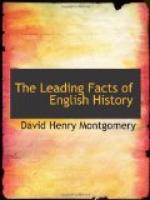Four years after Stephen’s accession Matilda landed in England and claimed the crown. The east of England stood by Stephen, the west by Matilda. For the sake of promoting discord, and through discord their own private ends, part of the barons gave their support to Matilda, while the rest refused, as they said, to “hold their estates under a distaff.” In the absence of the Witan or National Council (S80), London unanimously chose Stephen King (1135).
The fatal defect in the new King was the absence of executive ability. Following the example of Henry (S135), he issued two charters or pledges of good government; but without power to carry them out, they proved simply waste paper.
140. The Battle of the Standard (1135).
David I of Scotland, Matilda’s uncle, espoused her cause and invaded England with a powerful force. He was met at North Allerton, in Yorkshire, by the party of Stephen, and the battle of the Standard was fought.
The leaders of the English were both churchmen, who showed that they could fight as vigorously as they could pray (S136). The standard consisted of four consecrated banners, surmounted by a cross. This was set up on a wagon, on which one of the bishops stood. The sight of this sacred standard made the English invincible. (See map facing page 436.)
After a fierce contest the Scots were driven from the field. It is said that this was the first battle in which the English peasants used the long bow; they had taken the hist, perhaps, from the Norman archers at the battle of Hastings (SS73, 74). Many years later, their skill in foreign war made that weapon as famous as it was effective (S238).
141. Civil War (1138-1153).
For fifteen years following, the country was torn by civil war. While it raged, fortified castles, which, under William the Conqueror, had been built and occupied by the King only, or by those whom he could trust, now arose on every side. These strongholds became, as the “Anglo-Saxon Chronicle” (S99) declares, “very nests of devils and dens of thieves.” More than a thousand of these castles, it is said, were built. The armed bands who inhavited them levied tribute on the whole country around.
Not satisfied with that, these miscreants seized those who were suspected of having property, and, in the words of the “Chronicle,” “tortured them with pains unspeakable; for some they hung up by the feet and smoked with foul smoke; others they crushed in a narrow chest with sharp stones. About the heads of others they bound knotted cords until they went into the brain.” “Thousands died of hunger, the towns were burned, and the soil left untilled. By such deeds the land was ruined, and men said openly that Christ and his saints were asleep.”
The sleep, however, was not always to last; for in the next reign, Justice, in the person of Henry II, effectually vindicated her power. The strife for the crown continued till the last year of Stephen’s reign. Then the Church came to the rescue, and through its powerful influence the Treaty of Wallingford (in Berkshire) was made. By that treaty it was agreed that Matilda’s son Henry should succeed Stephen.




